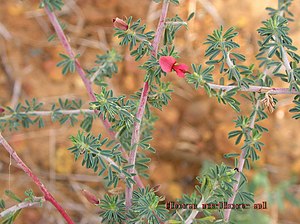Note: This is a project under development. The articles on this wiki are just being initiated and broadly incomplete. You can Help creating new pages.
Difference between revisions of "Indigofera aspalathoides"
(→Identification) |
|||
| Line 34: | Line 34: | ||
==Identification== | ==Identification== | ||
===Leaf=== | ===Leaf=== | ||
| − | {{Leaf|||}}<ref name="Leaf"/> | + | {{Leaf|Sessile|1-5 foliolate|Digitate, Crowed on the young branches}}<ref name="Leaf"/> |
===Flower=== | ===Flower=== | ||
| − | {{Flower||||}} | + | {{Flower|Solitary||Carolla dark pink||Exerted, Fileform, Longer than the leaves. Flowering season is Septemeber-January}} |
===Fruit=== | ===Fruit=== | ||
| − | {{Fruit||||||}} | + | {{Fruit||||||Fruiting season is Septemeber-January}} |
===Other features=== | ===Other features=== | ||
Latest revision as of 13:12, 30 June 2021
Indigofera aspalathoides is a low-growing shrub with copiously spreading rigid branches. The plant is a popular medicine in India where it is harvested from the wild for local use and trade. It is an ingregient of various proprietary preparations.
Contents
- 1 Uses
- 2 Parts Used
- 3 Chemical Composition
- 4 Common names
- 5 Properties
- 6 Habit
- 7 Identification
- 8 List of Ayurvedic medicine in which the herb is used
- 9 Where to get the saplings
- 10 Mode of Propagation
- 11 How to plant/cultivate
- 12 Commonly seen growing in areas
- 13 Photo Gallery
- 14 References
- 15 External Links
Uses
Leprosy, Cancerous affections, Secondary syphilis, Psoriasis, Wounds, Burns, Ulcers, Various skin diseases, Toothache, Mouth ulcers, Erysipela.[1]
Parts Used
Chemical Composition
Common names
| Language | Common name |
|---|---|
| Kannada | |
| Hindi | |
| Malayalam | |
| Tamil | |
| Telugu | |
| Marathi | |
| Gujarathi | |
| Punjabi | |
| Kashmiri | |
| Sanskrit | |
| English |
Properties
Reference: Dravya - Substance, Rasa - Taste, Guna - Qualities, Veerya - Potency, Vipaka - Post-digesion effect, Karma - Pharmacological activity, Prabhava - Therepeutics.
Dravya
Rasa
Guna
Veerya
Vipaka
Karma
Prabhava
Habit
Identification
Leaf
| Kind | Shape | Feature |
|---|---|---|
| Sessile | 1-5 foliolate | Digitate, Crowed on the young branches |
Flower
| Type | Size | Color and composition | Stamen | More information |
|---|---|---|---|---|
| Solitary | Carolla dark pink | Exerted, Fileform, Longer than the leaves. Flowering season is Septemeber-January |
Fruit
| Type | Size | Mass | Appearance | Seeds | More information |
|---|---|---|---|---|---|
| Fruiting season is Septemeber-January |
Other features
List of Ayurvedic medicine in which the herb is used
Where to get the saplings
Mode of Propagation
How to plant/cultivate
Indigofera species generally grow best in a sunny position, preferring a well-drained but moist soil.[4]
Commonly seen growing in areas
Photo Gallery
References
- ↑ Indian Medicinal Plants by C.P.Khare
- ↑ [Chemistry]
- ↑ [Morphology]
- ↑ Cultivation
External Links
- Ayurvedic Herbs known to be helpful to treat Leprosy
- Ayurvedic Herbs known to be helpful to treat Cancerous affections
- Ayurvedic Herbs known to be helpful to treat Secondary syphilis
- Ayurvedic Herbs known to be helpful to treat Psoriasis
- Ayurvedic Herbs known to be helpful to treat Wounds
- Ayurvedic Herbs known to be helpful to treat Burns
- Ayurvedic Herbs known to be helpful to treat Ulcers
- Ayurvedic Herbs known to be helpful to treat Various skin diseases
- Ayurvedic Herbs known to be helpful to treat Toothache
- Ayurvedic Herbs known to be helpful to treat Mouth ulcers
- Ayurvedic Herbs known to be helpful to treat Erysipela
- Herbs with Twigs used in medicine
- Habit - Shrub
- Index of Plants which can be propagated by Seeds
- Herbs that are commonly seen in the region of Sandy soils
- Herbs
- Pages without herbs images


